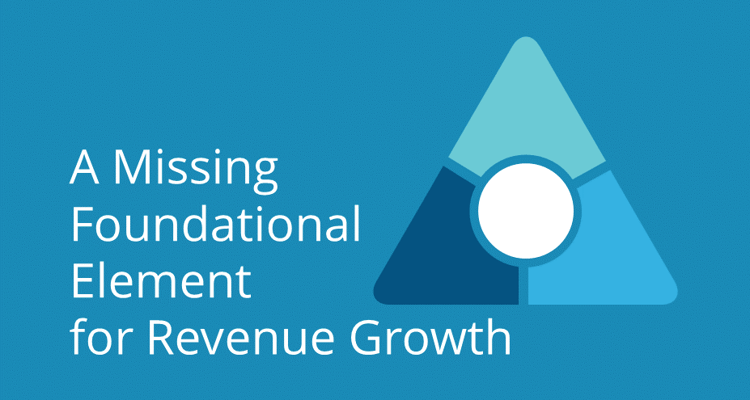
Sustainable long-term growth in any organization requires meticulous planning and execution. However, many organizations fail to plan appropriately at the inception, resulting in haphazard roadmaps, mismanagement of resources, and stymied growth.
But planning is not overlooked because management thinks it is inconsequential – it is most often subverted because it is simply difficult to do correctly.
Articulating the importance of planning at all levels of the organization is the first hurdle that management encounters when laying the framework for revenue growth. Furthermore, dedicating the time needed for planning is an obstacle that every organization in a fast-paced environment faces, especially public companies where shareholder expectations to increase revenue provide constant pressure.
However, the need to truly understand the benefits of planning and the underlying reasons why it fails, are more important in today’s business climate than ever before. Without this awareness, organizational growth cannot have a solid platform.
Strategic planning is the foundational element that revenue growth needs to succeed.
The Organizational Benefits of Strategic Planning
Before analyzing why planning usually fails and addressing how your organization can excel at it, it is important to dissect the short-term and long-term benefits. A well-articulated justification for planning aids in securing executive buy-in.
- More Complete Information
Shortcutting or skipping the planning stage can result in incomplete market research. Proper planning allows time to identify industry opportunities and realize competitive threats. The result is more thorough product research and development, and better strategic positioning within the market.
- Improved Structure
Planning not only lays the framework for the what of revenue growth, but also the how. Better division of responsibilities and more efficient cross-functional collaboration are two of the most obvious benefits of strategic planning. Furthermore, planning allows for the selection of growth milestones and appropriate KPI benchmarks. These elements combine to provide improved structure to guide efforts and evaluate success.
- Better Resource Management
Waste can be the downfall of even the most organized and effective organizations. Planning reduces waste by utilizing resources more efficiently. Better resource management of physical assets, employees, capital, and capacity is directly correlated with improved growth outcomes for organizations of all sizes.
- Reduced Chance of Failure
Setting clear expectations from the inception provides context to evaluate outcomes against, which in turn makes expectations more attainable. Additionally, planning for various scenarios in advance provides additional pathways to success if internal or external factors change, reducing the need for adapting on the fly. The result is a higher probability of long-term success.
- Ongoing Improvement
Like any other business operation, strategic planning has a learning curve. However, that break-in period can systematically fuel future growth. Learning from past planning successes and failures aids in subsequent efforts to increase the likelihood of positive future outcomes.
Strategic Planning Challenges
Clearly, planning is vital to any revenue growth strategy. However, planning is typically a dreaded topic at organizations of all sizes. Its reputation often precedes it due to past failures or difficulties. Evaluating where strategic planning can steer off course is the first step in putting together an action plan for success.
- Time Constraints
The single biggest reason planning gets overlooked is due to time constraints from:
- Executing a growth strategy too late in the business lifecycle
- Pursuing an unrealistic revenue growth plan
- Impatience from top-level management
- Inadequate staff capacity
- Pressure from a fast-paced industry culture
Pointless committees and meetings only exacerbate the issue by taking time away from worthwhile activities to "plan for the sake of planning". Within organizations where planning is valued in name only, short-term teams and committees are formed to plan for upcoming changes and are expected to meet regularly and put together plans and presentations for management. The result is a waste of time and motivation. Instead of preparing and inspiring employees to do their best work, planning discourages and frustrates employees.
- Unclear Leadership
Too many leaders driving the planning process results in unclear direction and can sidetrack planning altogether with politics and power struggles. A hazy organizational structure can also lead to muddled planning efforts, which is why many organizations choose to restructure before launching revenue growth models.
- Complacency
Organizations with a history of success often become complacent when it comes to planning for future growth. Resting on their laurels and assuming the market will come to them is a trap that many tradition-rich companies fall into, especially if their previous successes were largely unplanned for or came without much effort. Risky behavior typically results, undermining the business case for strategic planning in the future.
- Conflicting Worldviews
Within organizations, individual personalities can clash over conflicting ideas on the why and the how behind strategic growth efforts. Differing experience levels can also lead to ignorance about how to approach growth obstacles. Similarly, nuances in core values can result in disagreements over methodology and execution, complicating planning across divisions.
- Politics
Office politics between teams and individuals can destabilize planning because decisions become less strategic and more emotional. Nepotism, bids for promotions, personal agendas, and other political moves undermine the planning process by reducing rational decision-making and clouding judgement.
Tips for Strategic Planning Excellence
Analyzing where planning can fail is a safeguard against the most common mistakes in the strategic planning process. However, awareness alone does not chart the path to planning success. Excellence in planning requires keen internal and external observations, prediction of future outcomes, and alignment between goals and assets.
1) Industry Evaluation
Assess the overall market to identify top organizations and uncover emerging trends. Understanding which companies are succeeding provides a basis for analyzing individual success factors and lucrative market positioning. It also establishes a firm framework for identifying competitive advantage opportunities.
Identifying industry trends provides a trajectory for strategic growth modeling to follow that ensures planning efforts will continue to remain relevant. Planning without considering trends may result in revenue growth models that are outdated before they are even launched.
2) Organizational Audit
With a clear picture of the industry, audit your own organization to determine where it fits within the broader architecture of the industry.
Articulate your organization’s value proposition and objectively assess whether it boasts a competitive advantage to increase future revenue.
Determine what the organization has currently and what it is expected to have moving forward for financial resources, personnel, inventory, and capital investments. Examine how to leverage these assets to increase revenue in the short and long-term.
Recognize barriers to growth and determine how they can be reduced or eliminated. Identify which barriers you can work around and analyze where the organization could go if these barriers were no longer a consideration. Envisioning a barrier-free environment is the basis for goal setting.
3) Forecasting
Forecast organizational growth potential compared to projected industry growth and determine how to close or exceed the gap. Know what is in your pipeline for expected revenue, anticipated changes to product or service offerings, and analyze necessary changes to increase revenue forecasts.
4) Goal Setting
Clearly express revenue goals so that strategic planning can equip every level of the organization for success. Determine how profitability will be increased and set a firm time horizon to evaluate results.
Evaluate the sustainability of goals to guarantee that they will be attainable in the long-run instead of resulting only in a short-term surge.
Ensure all goals relate back to the organization’s core purpose and will contribute to this agenda over the long-term. Find lucrative options that drive the direction of the business in alignment with its original reason for existing.
5) Resource Requirements
Determine what the organization requires to succeed. Recognize that resources may not be traditional assets, they may also be internal actions or market factors that must align for success as well.
Prioritize resource needs according to the timeframe in the revenue growth plan and identify critical needs versus desires. Analyze contingency plans in case resources become unavailable or cost-prohibitive to acquire.
6) Execution
Even the best strategic plan is useless until it is acted upon.
Following through after planning with timely and effective execution is the most important part of a successful plan. However, executing a revenue growth strategy is not like pulling a trigger – it is more akin to pulling a wagon cross-country. Effective growth strategy execution involves the day-to-day work of slogging through mud and straining over mountains to get to a lush new location, and regular KPI reporting to assess your position.
Analyzing KPIs at regular intervals along the way will provide the check-ins needed to identify if the strategy needs to be corrected to keep moving in the right direction before the organization gets entirely off course.
The best way to succeed at strategic planning is to utilize a three-pronged approach – articulate the benefits, stay on the lookout for challenges that can subvert efforts, and execute proper strategy. However, organizational constraints in available time and personnel can hinder this approach, which is why many companies choose to bring in business growth consultants to manage the planning process and oversee strategic revenue development.
As you plan, feel free to use our B2B Business Growth Library.

